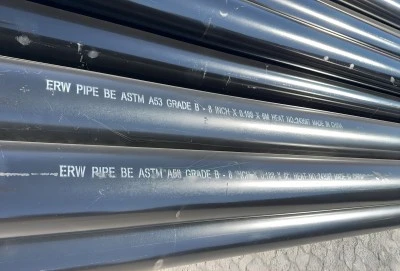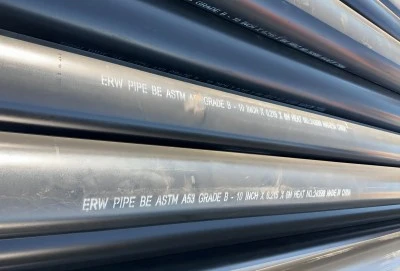In the world of steel pipe manufacturing, two terms often come up: HFW (High-Frequency Welded) and ERW (Electric Resistance Welded) pipes. These processes play a crucial role in producing high-quality steel pipes used across various industries. This article delves into the relationship between HFW and ERW, their applications, and the market dynamics surrounding electric resistance welded steel pipes.
|
|
|
HFW as a Type of ERW: Understanding the Core Relationship
To comprehend the relationship between HFW and ERW, it's essential to first understand what ERW entails. Electric Resistance Welding (ERW) is a process used to manufacture steel pipes by applying an electric current to heat the edges of the steel strip, which are then pressed together to form a seam. This method is known for its efficiency and ability to produce pipes with consistent quality.
High-Frequency Welding (HFW) is, in fact, a specialized type of ERW. The primary difference lies in the frequency of the electric current used in the welding process. While traditional ERW typically uses low-frequency currents, HFW employs high-frequency alternating currents, usually above 100 kHz.
The use of high-frequency currents in HFW offers several advantages:
1. Improved weld quality due to concentrated heat at the weld point
2. Faster welding speeds, enhancing production efficiency
3. Reduced heat-affected zone, leading to better mechanical properties of the weld
These benefits make HFW particularly suitable for producing pipes that require high-quality welds and excellent mechanical properties. However, it's important to note that both HFW and traditional ERW processes fall under the broader category of electric resistance welded steel pipes.
The relationship between HFW and ERW can be summarized as follows: All HFW pipes are ERW pipes, but not all ERW pipes are HFW pipes. This distinction is crucial for manufacturers and consumers alike when selecting the appropriate pipe for specific applications.
Applications & Standards: Where ERW and HFW Pipes Excel
Electric resistance welded steel pipes, including both traditional ERW and HFW varieties, find applications across numerous industries due to their versatility, cost-effectiveness, and reliable performance. Let's explore some of the key applications and the standards that govern their production and use.
Oil and Gas Industry: ERW pipes are extensively used in the oil and gas sector for transportation of petroleum products, natural gas, and water. They are particularly suited for onshore pipelines and gathering systems. The API 5L standard is commonly used for these applications, specifying the requirements for seamless and welded steel line pipes.
Construction and Infrastructure: In the construction industry, ERW pipes are used for structural purposes, such as support columns, scaffolding, and general fabrication. The ASTM A500 standard is often referenced for structural tubing applications.
Water Transportation: ERW pipes play a crucial role in water distribution systems and sewage networks. The ASTM A53 standard is frequently used for pipes intended for conveying water, steam, gas, and air in plumbing and heating systems.
Automotive Industry: HFW pipes, in particular, are favored in the automotive sector for their high weld quality and mechanical properties. They are used in exhaust systems, chassis components, and other structural parts.
Furniture and Equipment Manufacturing: ERW pipes are used in the production of furniture, exercise equipment, and various metal structures due to their strength and cost-effectiveness.
The standards governing ERW and HFW pipes ensure consistency in quality and performance across different applications. Some of the key standards include:
- API 5L: Specification for Line Pipe
- ASTM A53: Standard Specification for Pipe, Steel, Black and Hot-Dipped, Zinc-Coated, Welded and Seamless
- ASTM A500: Standard Specification for Cold-Formed Welded and Seamless Carbon Steel Structural Tubing in Rounds and Shapes
- EN 10219: Cold Formed Welded Structural Hollow Sections of Non-Alloy and Fine Grain Steels
These standards provide guidelines for chemical composition, mechanical properties, dimensions, and testing methods, ensuring that the pipes meet the required quality and performance criteria for their intended applications.
Market Dynamics: The Growing Demand for Electric Resistance Welded Steel Pipes
The global market for electric resistance welded steel pipes has been experiencing steady growth, driven by several factors that highlight the importance of these products in various industries.
Infrastructure Development: As countries worldwide continue to invest in infrastructure projects, the demand for ERW pipes in construction, water management, and transportation sectors has seen a significant uptick. Developing nations, in particular, are driving this growth as they expand their urban centers and industrial capabilities.
Energy Sector Expansion: Despite the global push towards renewable energy, the oil and gas industry remains a significant consumer of ERW pipes. The development of new oil fields and the maintenance of existing pipeline networks continue to fuel demand for high-quality ERW pipes.
Automotive Industry Trends: The automotive sector's shift towards lighter, more fuel-efficient vehicles has increased the demand for high-strength, low-weight materials. HFW pipes, with their superior weld quality and mechanical properties, are well-positioned to meet these requirements.
Technological Advancements: Ongoing improvements in ERW and HFW technologies are enhancing the quality and performance of welded pipes. These advancements are opening up new applications and markets for electric resistance welded steel pipes.
Cost-Effectiveness: ERW pipes offer a cost-effective alternative to seamless pipes in many applications. As industries look to optimize costs without compromising on quality, the demand for ERW pipes is likely to grow.
Environmental Considerations: The production process for ERW pipes is generally more energy-efficient compared to seamless pipe manufacturing. This aligns well with the growing emphasis on sustainability in industrial processes.
Market Challenges: Despite the positive outlook, the ERW pipe market faces challenges such as fluctuating raw material prices, increasing competition from alternative materials, and the need for continuous technological upgrades to meet evolving industry standards.
The market dynamics for electric resistance welded steel pipes are influenced by global economic trends, technological advancements, and shifting industry requirements. Manufacturers who can adapt to these changing dynamics and offer high-quality, cost-effective solutions are likely to thrive in this competitive market.
The relationship between HFW and ERW pipes, their diverse applications, and the evolving market dynamics underscore the importance of electric resistance welded steel pipes in modern industry. As technology advances and global infrastructure needs continue to grow, these pipes will play an increasingly crucial role in various sectors.
Longma Group specialize in producing electric resistance welded steel pipes with a wide range of standards, including ASTM A53 Gr.B; API 5L: Gr.B,X42,X46, X52,X56,X60,X65,X70,X80 PSL1 and PSL2; ASTM A252, ASTM A500, AS/NZS 1163, AS/NZS1074, EN10219, EN10217 and more, with options of BE (Beveled Ends) and PE (Plain Ends). Don't miss the opportunity to enhance your business with our excellent steel pipes. Contact us nowat info@longma-group.com to explore how we can be your reliable partner in steel pipe solutions.














